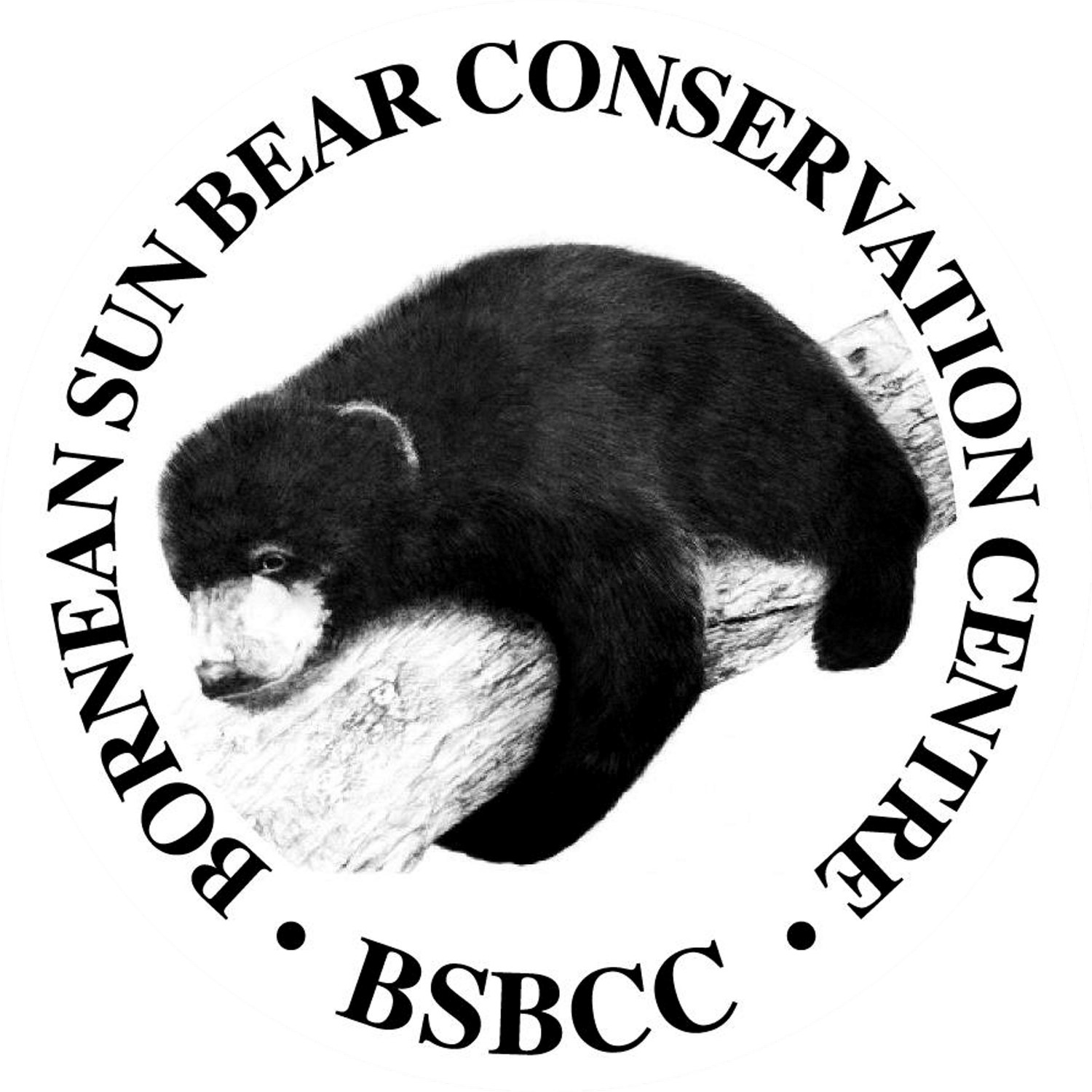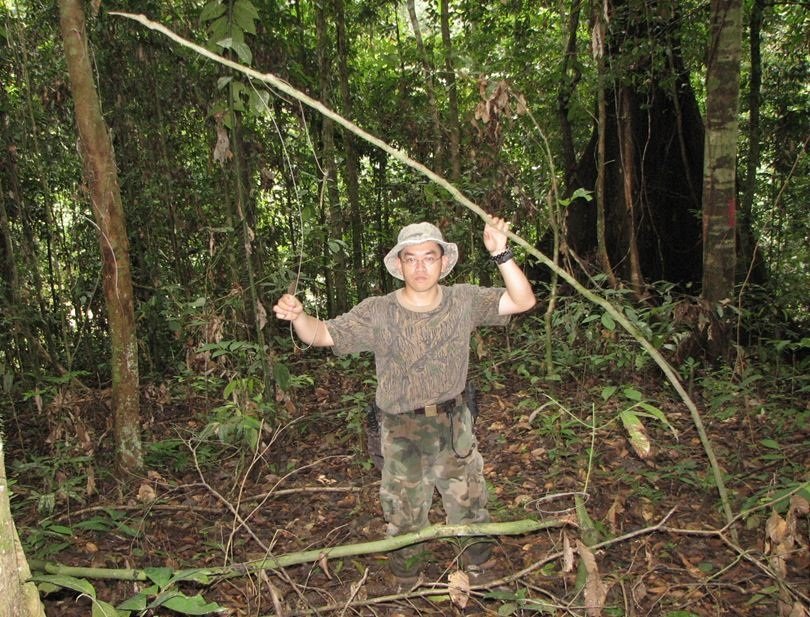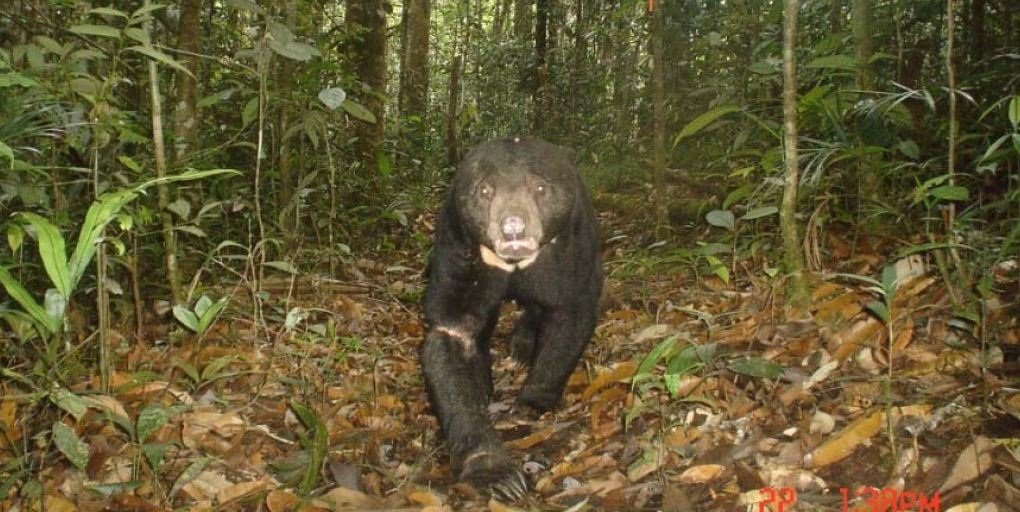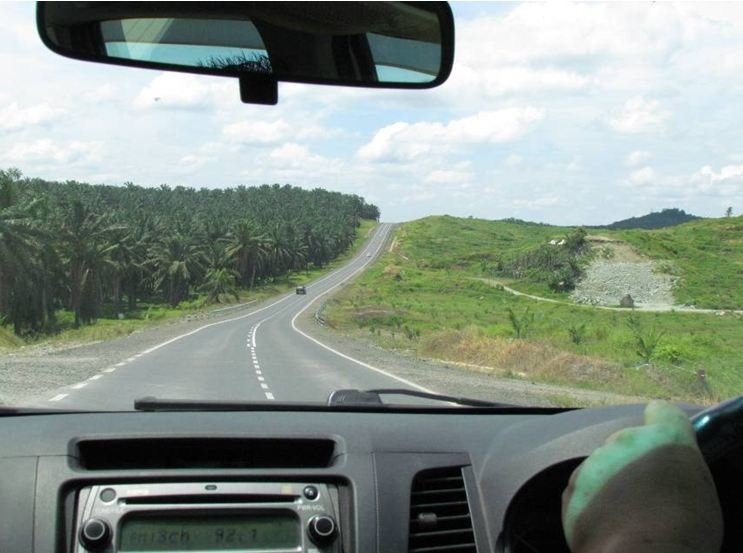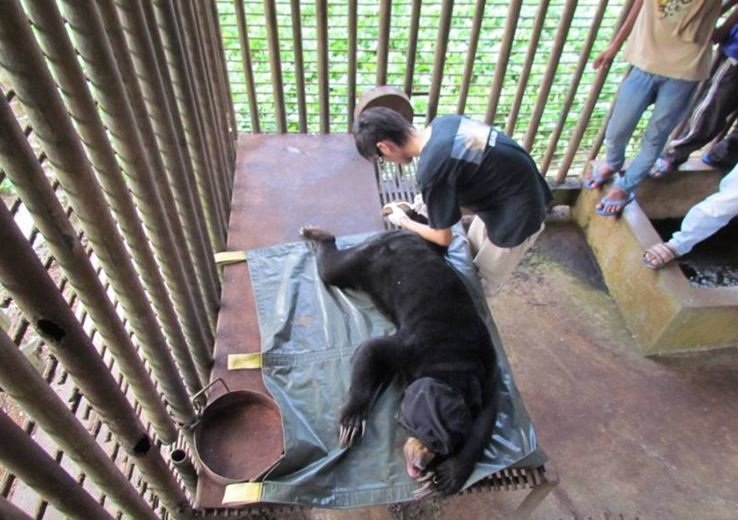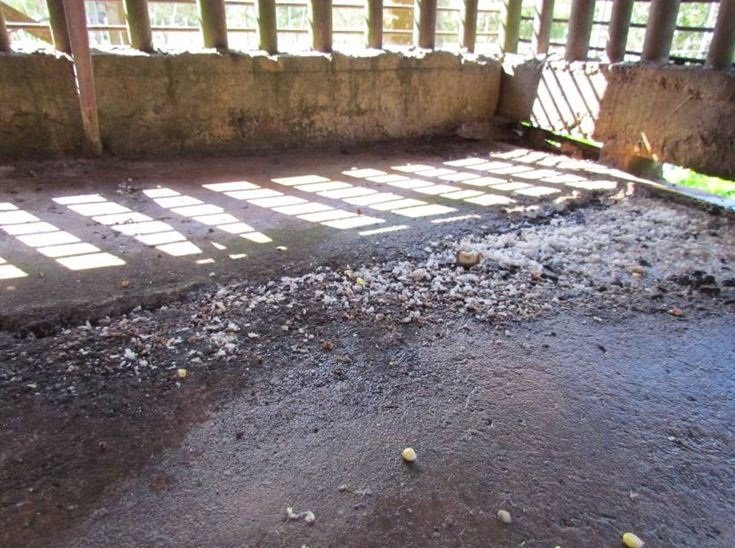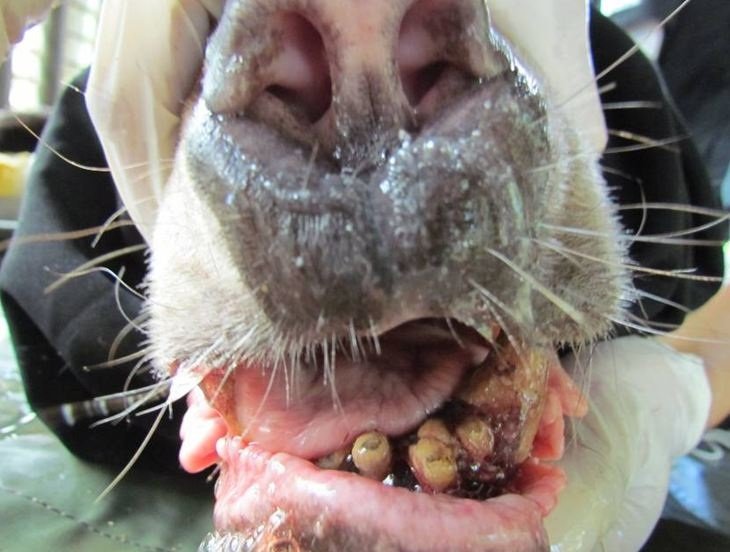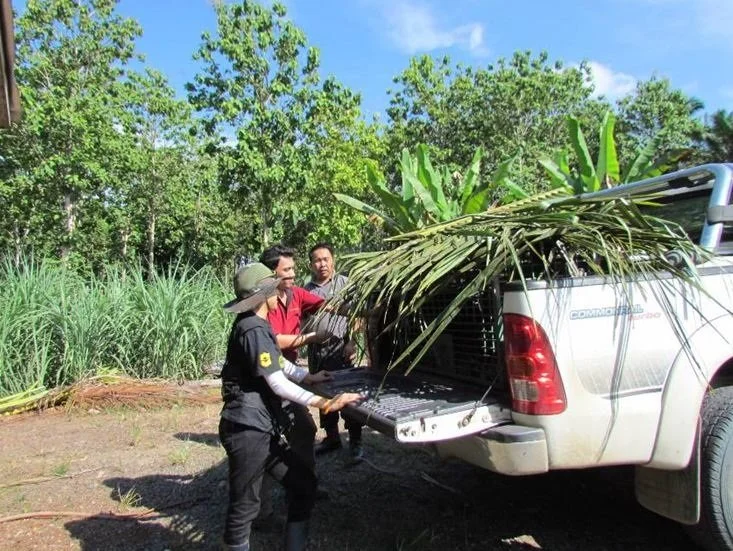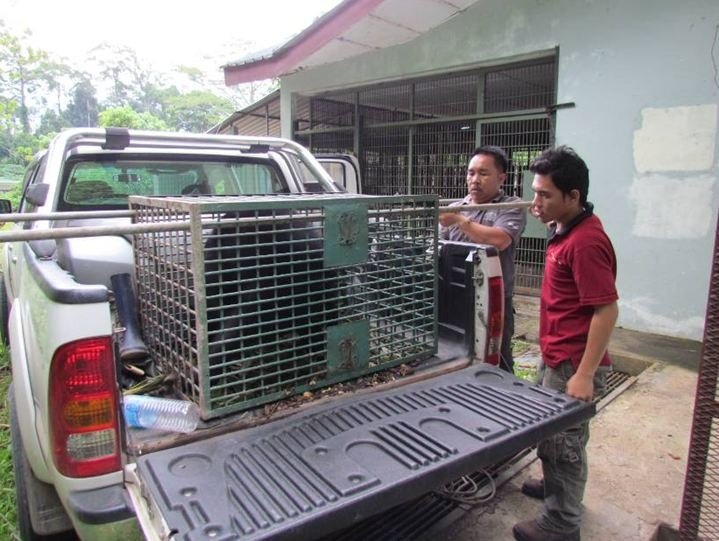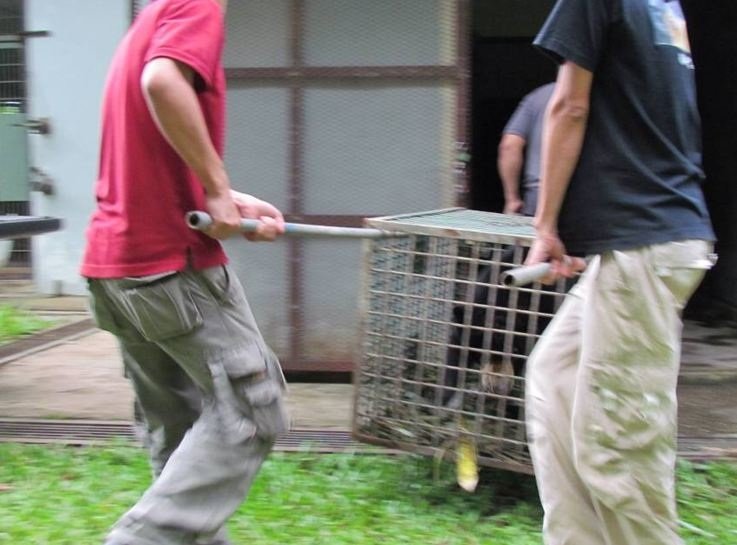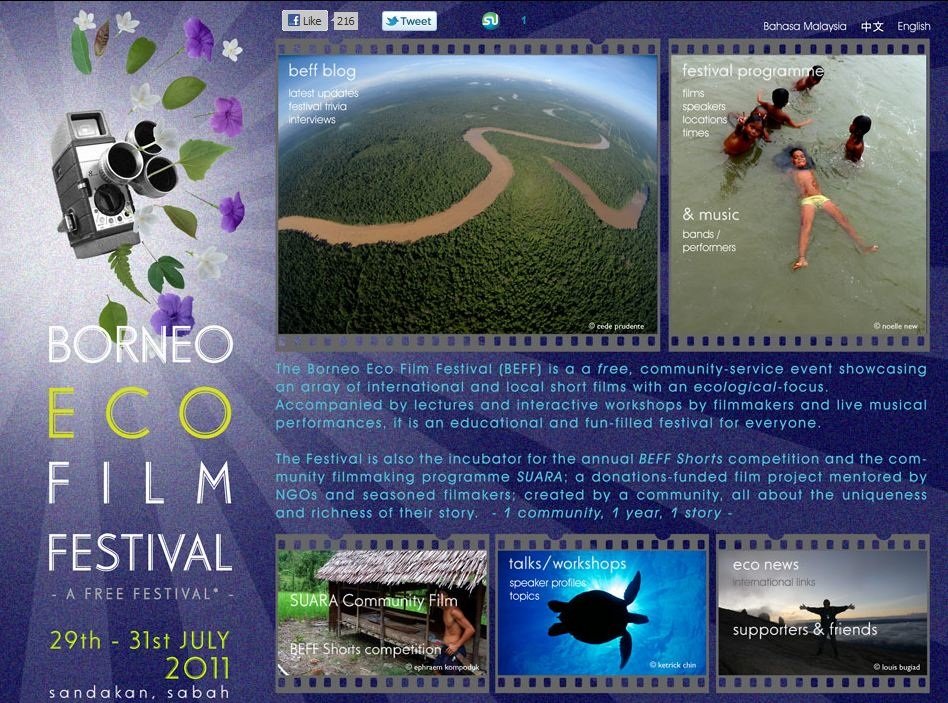Evidence mounting on snared sun bears
It all begins with an idea.
The three-footed sun bear reported at The Bornean Post recently is not the first of its kind.
THE VICTIM: The three-footed Malayan sun bear. Its injury is consistent with an animal having lost a limb while trying to free itself from a snare. — Photo by WWF-Malaysia/Mark Rayan.
The photo of this three-footed sun bear was captured by camera traps set by WWF Malaysia Team in the forest of Belum-Temengor Forest Reserve, northern West Malaysia. The bear was another victim of snares set to trap wildlife illegally in the forest. All terrestrial animals that roam the forest floor- from pheasants, lizards, pangolins, mouse deer, muntjacs, sambar deer, tigers, leopards, sun bears, tapirs, to elephants, can easily become targets of snares set by poachers in this region.
Snare or "jerat" in local Malay name, is a very common method of catching wildlife in this part of the world. The snares are simple, easy to construct and set, but effective and deadly to any wildlife that comes across its path. Only a piece of wire, cable, nylon rope, or heavy fishing line is needed from the poachers and the rest of the materials are taken from the surrounding to construct a snare: a tree sampling that act as a spring, few twigs as stepping board and triggering device. These snares are set on animal trails, near water wallows, salt licks, and other important wildlife traveling paths to increase successful catch. Sometime the poachers also construct simple but effective "fences" with a few small gaps (doors) where snares are set on these gaps. The fences drive/channel wildlife traveling on the forest floor to the gaps and the deadly snares. These fences often measured hundreds of meters with several dozens to a hundred of snares set on a "snare line" are norm to keen poachers.
Snare fence with a little "door" that funnel terrestrial wildlife into this particular spot with a snare loop set underneath this "door."
Victims of snares typically being killed slowly from injuries at the snare sites, after days of struggling to break free from the snares before the poachers came to check for their captures. Injuries from doing so cause excessive blood loss, broken bones, dehydration, stress, and infection. In some rare cases, other predatory species may prey upon the snared victims for an easy meal. Some animals that were slightly luckier managed to break free from snares by either pulling and twisting the snares with immense force until it was broken (imagine that snares are typically made from steel cable, wire, nylon ropes, and heavy fishing lines, breaking those tough materials are not easy tusk), or, in most cases where the snares failed to break, their caught arm or feet, "broke". In these cases, the victims deliberately chewed their paws/arm off so that their arm/feet can be freed from the snare and escaped. The escaped victims can either die slowly from these injuries from blood loss and infection, or, their body successfully fought the infection and wounds from the missing feet/arm/leg healed, such as this sun bear featured in this newspaper article.
With more researchers studying wildlife in Southeast Asia recently, we see more and more evidence of sun bears victimized by snares in the forest. This year alone, I have known of five different cases of sun bears being injured by snares. They represent a tip of an iceberg as many of the snared victims were injured and being killed unnoticed.
These sun bears were the survivals of snared victims:
Krau Wildlife Reserve, Pahang, West Malaysia. I was on a field operation to assist a local Malaysia student trapping wild sun bear for a radio-telemetry study on March 2011, we caught this 77 kg male sun bear with a missing front paw. "Beruang kudung" or "the amputated bear" is what the local aborigines called him. The missing paw probably resulted from the bear chewed off his own paw in an attempt to escape from snare. The wound healed. The bear survived! Lucky bear indeed!
Two weeks earlier, the same team caught another male bears with old snared wound on his hind foot, and fresh snared wound on his front foot. This bear was snared at least twice!
Kerinchi National Park, Sumatra. 2011: Sun Bear researcher Wai Ming Wong from Kent University, UK., photographed this three-footed bear from camera trap. The wound on the foot was almost a clean cut like being amputated on a surgical table.
Batang Turu Forest, Sumatra. 2011: Gabriella Frederickson, a well known sun bear biologist, set up camera traps in the forest reserve and took this picture of sun bear with two snare wounds in its right arm. Obviously the bear managed to escape with minor injuries. Will this bear be so lucky the next time when it is snare again?
Belum-Temengor Forest Reserve, Perak, West Malaysia. 2011. WWF-Malaysia team working with tiger photographed this sun bear with missing paw with camera traps.
THE VICTIM: The three-footed Malayan sun bear. Its injury is consistent with an animal having lost a limb while trying to free itself from a snare. — Photo by WWF-Malaysia/Mark Rayan.
Danum Valley Conservation Area, Sabah, Malaysia Borneo. On October 2007, three collage students from Germany who visited Danum Valley Field Center, saw a wild adult sun bear sitting on a open sandy ground beside of the Segama River, and concentrated licking on its arm, without noticing the presence of the students. The students watched the bears quietly and took photos and videos of the bear from the middle of the bridge. About 5 minutes later, the bear seems to pick up some sense from the air, sniffing and then limping away slowly. When the bear change its posture, the students can clearly see the bear’s left arm has a rounded open wound and a rope imbedded, and about a foot long rope was dangling at the other end. The left shoulder of the bear seems awkward, a bit out of place. The bear left the place.
After examined the photos and video clips they took, it seem clearly that the bear has a fresh wound from a snare set by poacher. The material of the snare seem to made from thick fishing lines and snapped off when the bear was pulling hard trying to escape. The struggling to escape seem intense as the rope cut through the bear’s skin, wounded the arm, and dislocate the socket on the left arm and thus the limping and awkward shoulder. The bear has a black sleek coat but emaciated with protruding ribs, hip, and leg bones. I strongly believe that the bear will slowly die from unable to feed properly with the injured arm. Read more about this snared sun bear here.
There is no question that poaching is a big threat of the survival of many wildlife in this region including sun bear. Saving wildlife from the hand of poachers is not just the job for law enforcement agencies but a responsibility for all of us at difference levels in the society. In development countries such as all the range countries of sun bears in SE Asia, enforcement of wildlife protection laws is not a high priority because of limited resources and lack of interest from the authorities. This is why the participations by people ranging from local communities to international NGOs and individual is becoming even more important, if we were to combat poachers and save our wildlife from extinction.
Please report any unlawful poaching and wildlife exploitation activities to the local wildlife authorities. If you have more information about poaching, snaring, and other illegal activities on sun bear, please contact me at wongsiew@hotmail.com or calling +60 16 555 1256.
More readings in poaching and snaring activities here:
We need your help to protect wildlife in Malaysia
Plight of the wild sun bears Category Archives: poaching
Poachers still ravaging M’sia’s wildlife
Big Dream Little Bears in 90 seconds
It all begins with an idea.
[kml_flashembed movie="http://www.youtube.com/v/XlZ03Zy3wjI" width="425" height="350" wmode="transparent" /]
Big Dream Little Bears by Wildhoop Productions. Narrator - Dr Audrey Low. Director, Editor - Howard Jackson.
Borneo sun bears are the most endangered, least studied and smallest bears on earth. In the rush to harvest the rain-forests of Malaysia these bears are literally fighting to survive.
Malaysia truly Asia
It all begins with an idea.
A brand new series of "Malaysia truly Asia" advertisements by the Tourism Malaysia Board will be aired across the world in the near future. Over the past few days, the production team has been filming at several tourism hotspots across Malaysia to take the most appealing scenes to promote tourism in Malaysia. One of the subjects chosen for this advertisement is the sun bears at Bornean Sun Bear Conservation Centre.
It started with many days of preparation and planning. Today the filming team and crews that consisted of about 40 people visited us to do the filming. The crew built an observation platform where the "talents" (actors and actresses) stood and viewed the sun bears in our state-of-the-art forest enclosure. Thanks to the cooperation of the weather, the forest, and our four legged actresses - Cerah and Jelita the sun bears, the filming went smoothly. The production team managed to film Cerah and Jelita foraging in the forest enclosure and climbing the trees where the production team hopes them to do so. After a tense hour of filming (as the bears are not use to a big crowd of people nearby and everyone has to stay quiet and complete still so that our actress did not run away), the director finally filmed what he wanted and a rap was called at noon.
We hope with the sun bears show up in this tourism advertisement, more and more people across the world can know about the presence of this little known sun bear that inhabit deep in the forest of Malaysia. We would like to thank the production team for featuring the sun bear at our centre, the sun bears (Cerah and Jelita) for behaving so well today, and finally the cooperation of forest residents to make this filming possible. Thank you all!
Action!
Cerah the sun bear showed up and moved into the camera.
Jelita the sun bear soon followed and started to climb a tree.
No CONDENSED MILK for HONEY BEAR!
It all begins with an idea.
Text and photos by Ng Wai Pak
It was two weeks ago when someone informed me that her friend had a sun bear that needed rescuing. Concerned of the whole situation, I got to my feet and instantly reported to the Sabah Wildlife Department. Very soon a rescue operation plan was well on its way. Boy was I glad that the department allowed our keeper, Daniel, and me to follow up with the whole operation from the beginning until the end.
On the morning of the 23rd July 2011, Dr Diana (Sabah Wildlife Rescue Unit), En. Azari (Sepilok Orang Utan Rehabilitation Centre), Daniel, and I (BSBCC) did the final check for the essentials before we started our journey to Lahad Datu. It’s sad that how most of the time we only get limited info about the bears that we are going to rescue, and most probably the information obtained might be inaccurate. Hence, to get ready for any unforeseen circumstances is a must!
I had my check list with me, and I made sure everything was on board for the journey. Translocation cage: Check. Medical box and sedation kits: Check. Camera and evaluation forms: Check. Okay team, all set and ready to go!
After a 2 hour drive and miles and miles and miles (yes, I mean MILES!) of monoculture plantation scenery, we then stopped in front of an oil palm mill and waited for Mr. Tew who was the person in charge of the local oil palm plantation. He then brought us into his plantation and showed us where the sun bear was kept.
And there he was, an adult male sun bear kept in a metal enclosure which was definitely bigger compared to the common local “dog kennel” cage. It was a hot and sunny afternoon, and the scorching sun was shining right above our heads.
He wasn’t really making things easier when the bear started to pace on the cement floor as well as on the rusted metal bed and later continued to bark at all of us. It was obvious that the bear was under stress, and probably sensing that something was going to happen, tried to get away from the cage he called home, a place where he has lived in for the past 18 years.
Everything was ready and Dr. Diana, looking like a female military officer in her all blacks attire and gumboots, aimed carefully and sedated the bear with her dart gun. An almost silent ‘whoosh’ and before you know it, within 10 minutes after the aim, the 47 kilogram male sun bear became slow in his pace and finally dropped unconscious on the floor. We then entered the enclosure and immediately started checking on the sun bear’s health. We found that his oral health condition was in quite a serious state. He has a lot of tooth decays and loose teeth as well as gingivitis. Despite that though, the bear was in good condition. Right before we placed him into the translocation cage, Dr. Diana gave him the multivitamin and antibiotic injection.
Later on, I interviewed the worker who took care of the bear. I was shocked to find out that the cause of the bear’s oral problem was due to his unhealthy diet. Well, try imagining this: two kilogram of empty porridge and 4 cans of condensed milk EVERYDAY. I don’t think I would be a very happy sun bear if I was fed that way for the past 18 years of my life. In fact, such unbalance and unnatural food is very commonly provided by the illegal owners to their pets, doesn’t matter if it is a bear or an orang utan.
Mr Tew admitted that he has no idea what a bear’s natural food would be. He didn’t know and assumed that condensed milk and rice porridge would be good enough to keep the bear alive and kicking. Well, I guess it did just that but the effect on the bear now is too much to bear.
I guess at this point you might be wondering how Amaco ended up living in the middle of an oil palm plantation. It was just back in 1993 when a group of workers were clearing the forest for the preparation of the new plantation when they found a cute little bear cub in the middle of the forest. They took him and named him as Amaco. Since then, Amaco has been kept in the metal enclosure, until recently, someone informed them about our centre.
After all the health check, we straight away sent Amaco back to BSBCC. By the time we arrived (which was already half past five), Amaco has already recovered from his sedation. It took us sometime to move him into the quarantine cage, for he was starting to growl and bark at us. For now, our plan is to monitor Amaco’s health condition and will start soon enough on a 30 days quarantine period for him. Definitely for sure, no condensed milk for him anymore!
Spreading The Word
By Paul Clenton
Repost from
http://bearingupinborneo.wordpress.com/2011/08/02/spreading-the-word/
I had to make my own “bear” to show the audience. Damn those CITES busy-bodies! (the t-shirt was made by a local woman who gave it to me when I got back from Sabah).
I’ve been back in the UK a while now and recently got the opportunity to talk to some local people about sun bears and the BSBCC. I was asked by some local people whom I’d spoken to before if I could do a talk at the local village hall.
As preparation I made a couple of slideshows and downloaded some video clips from the net. I also made some posters to put up on local community noticeboards, I also made a plywood sillouette of a sun bear to give a “presence” when called for. I managed to beg the use of the local community centre off the powers-that-be and even convinced a local priest to lend me a projector.
The evening went well. Although the venue was hardly packed, money was raised which can pay for some keepers’ wages, bear food or put towards the development of the BSBCC. Moreover, I was approached by several people at the end who told me how much they enjoyed and appreciated the evening and went on to say that they would ask organisations they were involved with. I currently have 2 groups who would like me to do talks for them in the coming months.
It has been a very meaningful and rewarding experience to take a basic will to help and essentially make something out of nothing. I am by no means an expert at this, but practise hopefully makes perfect. Why not have a go yourself, starting in your own area? Anyone can do this. We can all do something to help the sun bears, and letting the world know they exist is a good start.
With Thanks from BEFF 2011
Text: BEFF
Photos: BEFF, Cede Prudente
http://borneoecofilmfestival.blogspot.com/2011/08/with-thanks-from-beff-2011.html
With Thanks from BEFF 2011
How cool was it to have a rare King Cobra, about 12 foot long, attempting to participate in the BEFF 2011 at the Rainforest Discovery Centre! And how appropriate that Cedde Prudente was talking about the “Wild Wonders of Sabah”. We know his photographs are amazing and beautiful but we didn’t know he has a following from wild creatures, too!
We were half wondering whether the sun bears will also be in attendance during Wong Siew Te talk on “The holistic approaches to Bornean Sun Bear Conservation Centre (BSBCC) to conserve sun bears in Sabah”.
You can go to BSBCC website for further information about BSBCC work and Bornean sun bears. Watch the BEARTREK demo reel here, one of the film screened in the BEFF 2011. Not many people are aware of the plight of the Bornean sun bears. BEFF 2011 is pleased to have been able to at least provide some sort of avenue for creating awareness on the great work of BSBCC and the plight of Bornean sun bears. It is amazing to see and be in the presence of someone so passionate about his work in protecting the sun bears. It was indeed a privilege to have Wong be a part of BEFF 2011. Save sun bears!!
Nikon Malaysia gave an interesting presentation on “Movie-Making with a Nikon DSLR”, and some goodies giveaway for those who can name international and local film directors. Nikon Malaysia also sponsored the prizes for the lucky draw during BEFF 2011. Thank you Nikon Malaysia!
These three talks launched the BEFF 2011 on Friday 29th July. Then it was a mad dash to Nak Hotel for the film screenings which began at 7pm. The screenings were held at Balin Rooftop Restaurant and Bar, an open air area on the roof top of Nak Hotel. And what a view!! The sunset, the sea, the shop buildings and there was a huge navy ship docked at the bay about 200 meters from the BEFF venue.
Husband and wife team Anton and Linn (BEFF main organizers) did a wonderful job of setting up the venue and providing the space for BEFF 2011 film screenings.
BEFF 2011 saw the screening of 15 thought provoking films by Abdul Hamid Abdullah, Arry & Fizzah, Joe Pontecorvo & Chris Morgan, JICA & Scubazoo, BorneoColours, Mai Iskandar, Ikhwan Rivai, Cassia Mary Itamoto & Celina Kurihara, Audrie Yeo, Patrick Rouxel, BBC & Roger Munns, WWF & Harun Rahman, Dario Novellino & ALDAW Networks, ASEAN Centre for Biodiversity Conservation, and Thorfinnur Gudnason and Andri Snaer Magnason. The screening was made extra special by the presence of some of the filmmakers in BEFF 2011 to answer questions about their films. Now that is what we call "access"! The questions posed were equally thought provoking and we are sure many who were there at BEFF 2011 left with greater awareness about our environment and how we can all contribute towards the protection and preservation of our natural habitat.
The film screenings were made even more special with the presence of talented and award winning musicians Christopher Aban; Amir Yussof and friend; Roger Wang; Angelina Perete; Hezekiah Asim and wife Kalina who performed a Borneo Orang Ulu dance. Strong wind, dark clouds and lightning did not stop the audience from clapping their hands in rhythm with the music elegantly sang by Angelina accompanied by the masterful sound of Roger Wang on the guitar, and what looks like a wooden-vase-cum-drums (Udu Vase?) played by multi-talented Hezekiah who also played the Sompoton (Bornean flute), Hulusi (Chinese flute made using bamboo and gourd), as well as the Sape (a traditional lute of Bornean Orang Ulu). Amir Yusof performed his excellent and meaningful song "Calling on you". Here's a clip of Amir singing the song (clip taken from Youtube):
[kml_flashembed movie="http://www.youtube.com/v/k9OTk9nVBq8" width="425" height="350" wmode="transparent" /]
The final day was a closed session, the SUARA Workshop: Community Filmmaking, which was facilitated by Ulu Papar Community Researchers, Inanc Tekguc, Artiso Mandawa and Global Diversity Foundation, and filmmakers Chris Chong Chan Fui and Ikhwan Rivai. This year's community is HUTAN, a non-profit organisation working to develop and implement innovative solutions to conserve the orang-utan in Sabah, Malaysia.
Overall, about 300 people, from Malaysia, U.S.A., Netherlands, Sweden, Canada, England and others, the Minister of Youth and Sports Sabah, Sandakan Municipal Council President, and representatives from organisations such Sabah Society, Kota Kinabalu International Film Festival attended BEFF 2011 from 29th to 31st July 2011. On average about 35 participants attended each sessions on film and documentary making by Harun Rahman of Novista, Chris Chong Chan Fui of Tanjung Aru Pictures, Ikhwan Rivai of Wildman Pictures, and Roger Munns of Scubazoo. Each one of the esteemed speakers generously shared with the participants their knowledge, acquired through years of experience, on film making. These include pre-production and post-productions matters, equipments, writing proposals, research, difference between a subject and story, the importance of using good tripods, how to ensure the sound recording for your film is good, story arc, where to start, how to get your film out there, plots and characters, character arc, importance of good storytelling, funding, pitching, legal matters and many more, about documentaries that make audience ask questions, about telling your own story your way, and as Chris puts it "why not?". Roger's talk on underwater filmmaking left the audience sitting on the edge of their seats as Roger shared the thrills, tribulations and fun of underwater filmmaking.
At the end of the day, each filmmakers were unanimous in their message that if you want to be a filmmaker, the best way to start is to just go out there and start filming. Let your imagination run free, be creative, and to just have the mindset that you just have to do it right now and you have what it takes to make things happen. Be the filmmaker that you are right now!
Finally, our sincere gratitude to all who believed in the BEFF 2011 and made it possible! Join us again for the BEFF 2012!
More photos of BEFF can be view here:
http://borneoecofilmfestival.blogspot.com/2011/07/yay-what-fantastic-beginning-for-beff.html
http://www.facebook.com/media/set/?set=a.238496172851076.67057.100000720843670
Wong's note:
A big congratulation to the BEFF organizing committee and BEFF team to make this festival a success in Sandakan! You guys rock!
A big thank you and hugs for your invitation for BSBCC and the sun bear team to be part of this important event. This is by far a good place for us to raise awareness for sun bears and everything we care about- Mother Earth. I am looking forward to be part of BEFF again in the future!
Thank you!!
Cheers,
Wong
BSBCC latest news July 2011
Repost from http://leapspiral.wordpress.com/2011/07/29/bsbcc-latest-news-july-2011/
MORE NEW BEARS
Two more new bears arrived at BSBCC on 22nd April 2011. Named Mamatai and Wan Wan, both are adult females and were transferred to BSBCC from Lok Kawi Wildlife Park in Kota Kinabalu by Sabah Wildlife Department.
INFRASTRUCTURE CONSTRUCTION
Several local contractors have submitted tenders for the BSBCC observation platform and access boardwalk construction and we hope that work will start in August this year. Meanwhile the search is still ongoing for funding for the construction of the remainder of the proposed buildings, ie. the new bear house and its forest enclosures and the visitor reception and new bear holding areas.
NETWORKING & SPREADING AWARENESS
In June, Wong and Wai Pak attended the Asia for Animals 2011 conference in Chengdu, China, hosted by Animals Asia Foundation. Later on in June, they also took part in the Borneo Carnivores Symposium, held in Kota Kinabalu, Sabah, which brought together leading carnivore researchers working in Borneo.
Wong delivering his talk on ’The Holistic Approach of BSBCC to conserve sun bears in Sabah, Malaysian Borneo’ in Chengdu.
Wai Pak on a field trip to the centre for rescued moon bears near Chengdu.
FUND RAISING
An innovative event held by volunteers and supporters of BSBCC on Facebook raised an amazing USD4,152 through just two days of donations and a special on-line prize draw of donated sun bear items like paintings, artwork, soft toys and bags, from June 11-12, 2011. Many thanks to everyone involved!
BSBCC VISITORS
None other than the man deemed the ‘Greenest Person on the Planet’ in 2008 by 3rd Whale in Canada, Matthias Gelber, visited BSBCC on 3rd June to learn more about sun bears. BSBCC also collaborated with the Sabah Forestry Department Rainforest Discovery Centre (RDC) to present a talk by Matthias to RDC Junior Rangers, local teachers and headmasters, parents and some visitors, at the Sepilok Orang Utan Rehabilitation Centre AV room during the visit.
Matthias and friends at BSBCC’s new bear house.
Caroline Gabel, long-time supporter of Wong’s research and BSBCC, paid a visit on 17th June 2011 with Wong to see for herself the good work being carried out at the Centre. Caroline is the CEO and Founder of the US-based Shared Earth Foundation, and a passionate advocate of wildlife conservation.
Caroline and Wong in the new bear house.
BSBCC was also happy to welcome sun bear researcher Gabriella Fredriksson from the Sun Bear Environmental Education and Research Centre near Balikpapan in Kalimantan, Indonesia. Gabriella stayed from 25th-30th June, exchanging ideas and expertise with Wong and Wai Pak and discussing future collaboration with BSBCC.
Gabriela showing Danial, Roshan, and Wai Pak how to conduct bear transect study in the forest.
On 29th July BSBCC was very excited to receive a visit from Joe Pontecorvo, the Producer and Director of the film series Bear Trek and also Bears of the Last Frontier. Joe was part of the team that previously filmed Wong carrying out his research in 2007.
